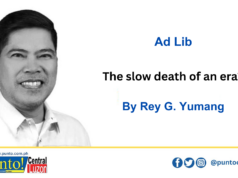IN A league thoroughly of its own. That was the City of San Fernando under the stewardship of Oscar S. Rodriguez.
Just about every conceivable award of recognition was heaped upon the capital city – from Most Business-Friendly City, where it was enshrined in the hall of fame, to Most Successful LGU in the institutionalization of business processing and licensing reforms; from Top 10 Most Competitive Cities in the Philippines to the Seal of Good Housekeeping, hall-of-famer there too, if we’re not mistaken.
And the most precious jewel in the crown – the Gawad Galing Pook for Outstanding Local Governance Program:
Making Governance a Shared Responsibility. Made more radiant by the Special Citation on Local Capacity Incentive Mechanism for Local Governance given the city by the United Nations Development Programme and the Galing Pook Foundation.
Correspondingly, just about every conceivable honor was bestowed upon Mayor Rodriguez – from No.4 in World Mayor Prize to the 2012 Presidential Lingkod Bayan Award personally handed him by President BS Aquino III, for “successfully elevating the City of San Fernando through a system of managing governance and performance that is anchored on the principles of transparency, accountability and participatory governance.”
For the record – paging Guinness’ – from 2004 to 2012, the City of San Fernando and Mayor Rodriguez shared at least 69 awards: four from international bodies, 31 from national competitions, and the rest regional in scope.
Balanced score card
All these, Mayor Rodriguez readily credited to his administration’s commitment to the Performance Governance System (PGS), with the Harvard-developed Balanced Score Card as primary instrument.
So good was the city government’s application of the PGS from its inception in 2005, that in 2012 the Institute for Solidarity in Asia (ISA) conferred on it “Institutionalized Status,” the highest in ISA’s rating system, and the first ever in the entire Philippines.
Indeed, so exemplary was the City of San Fernando’s PGS experience that the ISA had to craft for the city the Maharlika Hall of Fame Award for PGS Institutionalization.
Revolution in governance
“This is a revolution in governance for development, because all the while, we have been emphasizing democracy, freedom. And that’s fine. That is a battle we have already won. What we are really looking at is: Can we use that democratic space for the genuine, integral and total development of our people?
“I think you have the best example right here in San Fernando. You can lead the way…” Thus spake ISA President Jess Estanislao, once finance secretary, at the conferment rites. Further apotheosizing Mayor Rodriguez thus:
“That is why the leadership of Mayor Oca is critical. And these good things are coming right out of San Fernando.
With the country’s corruption index going up and up and things going the wrong way all the time, you come to San Fernando and ask: Is this possible? Are you really in the Philippines when you begin seeing and talking about all these projects? That is why, if you are looking at a real revolution in governance, it is right here in San Fernando.”
So fixed in the collective mind – not necessarily, the intellect – of the people of Pampanga is the premiership of the capital city in good governance, with Mayor Rodriguez as avatar, that any report to the contrary is readily deemed a lie, and a libel on Rodriguez.
Fund misuse
In August last year, the committee on good government, ethics and public accountability of the city council noted “the questionable use or misuse of public funds in 2012 (amounting to some P86 million) and in 2013 (totalling to P153.2 million)” and the “alleged blatant disregard of controls and procedures as stated in the New Government Accounting System, and gross negligence in the performance of official duties.”
The committee report authored by its head, Councilor Lito Ocampo also questioned the “planned purchase of supplies for the second semester of 2013 amounting to P19,437,537.63 despite of (sic) the large inventory of supplies amounting to P136,836,902.07 as of June 30, 2013.”
The report further revealed the estimated Cash Flow Statement for the second semester of 2013 as: General Fund of P310,525,027.19 (as of June 30, 2013) deposited at Land Bank; and estimated receipts from July 1 to December 31 amounting to P389,074,877.22, for total available cash of P699,599,904.41. Somewhere in the process of turning the committee report into a news story, the word “bankruptcy” intruded.
Quick was new Mayor Edwin Santiago in disengaging his administration from the dreaded scarlet “B” thus: “I am not saying that the city has no money.” Readily admitting though that of a P960 million projected collection, P660 million is already spent from January to June 2013 under the Rodriguez administration, leaving only the difference of P300 million to be collected by the city treasurer for the period of July to December 2013.
Conclusions readily drawn from there. Cracks in the good governance façade of city hall observed. Quicker though was Rodriguez, now congressman, in repudiating all allegations of bankruptcy at city hall, fearing that more than his being maligned, it is the image of the city government that has been damaged.
In a press briefi ng, still in August 2013, Rodriguez showed a certificate from the Land Bank, stating a total deposit of P447,110,363.32 as of June 30 of that year. Rodriguez explained that from January to June 30, 2013 the city generated revenues from the Internal Revenue Allotment (IRA) and local income sources amounting to P597,822,351.37 which when added to the balance of over P400 million will amount to about P1 billion.
So where was the bankruptcy? Roma locuta est, causa finita est. As with Rome, so with Rodriguez. He has spoken. The case is closed. Or is it?
Dismal scorecard
Last Wednesday, Sun-Star Pampanga bannered: DOF discloses LGUs’ fiscal performance, reporting, among others:
“For the City of San Fernando, the overall revenue generation capacity in 2010 and 2012 showed “a poor level of regular and local incomes for a first-income class city.” However, the DOF [Department of Finance] explained that it could not make a substantive analysis both for the revenue and expenditure indicators due to the absence of the required reports for 2011.
The DOF noted that “with the SRE report for FY 2011 still unavailable for more than 2 years now, it appears that there is a deliberate neglect in complying with the directives of Department Order No. 8 -2011, thus undermining the accuracy of the aggregate LGU report of the BLGF.”
…the City of San Fernando also had a “very low” expenditure per capita in 2010 at P2,826 and in P2012 at P3,013 when compared with the average expenditure of P3,919 and P4,060, respectively for first class cities. The city also utilized less than 20 percent of the IRA for local development projects.
The years covered by the disturbing report were within Mayor Rodriguez’s last term. Wanting to learn further, I hit http://iskor.blgf. gov.ph and right there is the Preliminary LGU Fiscal Sustainability Scorecard of the City San Fernando for the years 2010, 2011 and 2012, distinguished by red marks of “Poor,” “Failed,” and “Incomplete.”
Indeed, entries in the FY 2011 column were uniformly in red “No Report” underpinning the objective verity of “deliberate neglect in complying with the directives of Department Order No. 8 -2011” on the part of the city government.
The bottom scores for the city read: D for Average in 2010, F for Poor in 2011, and E for Needs Improvement in 2012. Dismal grades befitting as much a Row- 5 pupil in the boondocks as a fifth-class LGU in the backwaters. Not the multi-awarded first class city that is San Fernando! So totally un Rodriguez!
The PGS Scorecard made the City of San Fernando the very template of good governance. And Oscar Rodriguez monumentalized in bronze. The DOF Scorecard made the City of San Fernando a shattered showcase of even the most elemental of public governance. And Oscar Rodriguez’s in heroic bronze deconstructed to a cardboard mock-up. Pun unintended there.
Where lies the real score?




